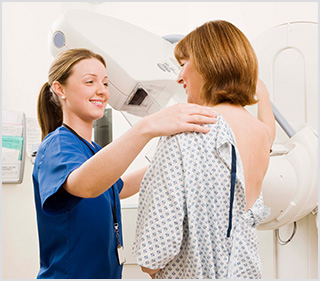How do Women React to a False-positive Mammogram?
A new study found that women who have a false-positive screening mammogram are more likely to delay their next breast cancer screening.

Screening mammography to detect breast cancer before a woman shows signs or symptoms has the potential to catch the disease at an early stage, when it is more likely that it can be successfully treated. However, screening also carries risks, including the chance that it will yield a false-positive result.
A false-positive result occurs when an abnormality seen on a screening mammogram turns out not to be cancer after additional tests such as diagnostic mammography, ultrasound, or tissue biopsy.
More than 50 percent of women in the United States who have annual screening mammograms for 10 years will experience a false-positive result, according to the National Cancer Institute.
Women who have a false-positive result from a screening mammogram often experience emotional, physical, and economic stress, according to Firas M. Dabbous, PhD, the lead author of a new study that was published recently in Cancer Epidemiology, Biomarkers & Prevention, a journal of the American Association for Cancer Research.
The study showed that women who had a false-positive result from a screening mammogram also were more likely to delay or forgo their subsequent screening mammogram than women who had a true-negative result.
“This suggests that we need to more actively encourage women who have a false-positive result from a screening mammogram to adhere to routine screening mammography recommendations because it has been shown to reduce breast cancer mortality,” said Dr. Dabbous, who is manager of patient centered outcomes research at the Russell Institute for Research & Innovation at the Advocate Lutheran General Hospital in Park Ridge, Illinois.
For the study, Dr. Dabbous and his colleagues analyzed data from 261,767 women who received mammography screening through a large health care organization with multiple facilities in the greater metropolitan Chicago area.
They found that women who had a false-positive result were significantly less likely to have a subsequent screening mammogram in the database than women who had a true negative result.
They also found that among the women with more than one screening mammogram in the database, those who had a true-negative result from the first mammogram were 36 percent more likely to have returned for a subsequent screen in the next 36 months compared to women who had a false-positive result.
When delay in having a subsequent screen was defined as any mammogram performed more than 12 months after the first screening mammogram, the median delay was 13 months for those who had a false-positive result compared with three months for those who had a true-negative result.
“We believe that the delay in subsequent screening for women who have an initial false-positive result increases the probability that they will subsequently receive a later-stage breast cancer diagnosis compared with women who first have a true-negative result from a screening mammogram,” said Dr. Dabbous.
In fact, he and his colleagues found that the four-year cumulative risk of a late stage at breast cancer diagnosis was 0.4 percent for those who had a false-positive screening mammogram compared with 0.3 percent for those who had a true-negative result. This difference was statistically significant.
According to Dr. Dabbous, the main limitation of the study is the lack of ability to follow the women who did not show up for their next screen in this health care system because some may have received subsequent mammograms at different institutions. However, he noted that the results were similar when restricted to those who remained in the system and so he and his colleagues are confident that this limitation did not bias the results.
The study was supported by a grant from the Agency for Health Research and Quality.
